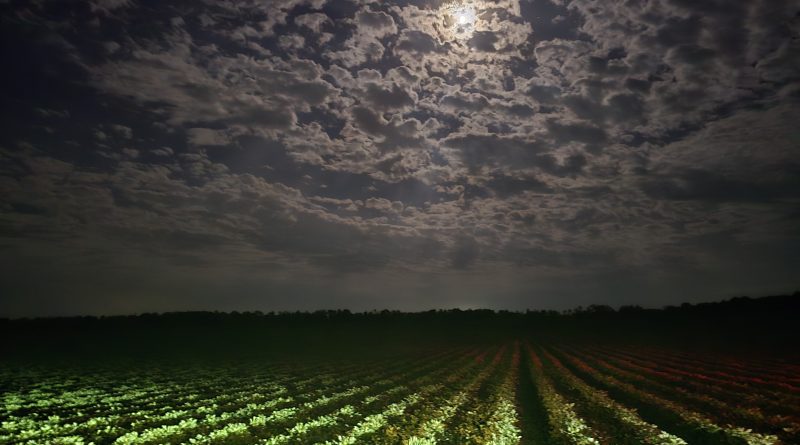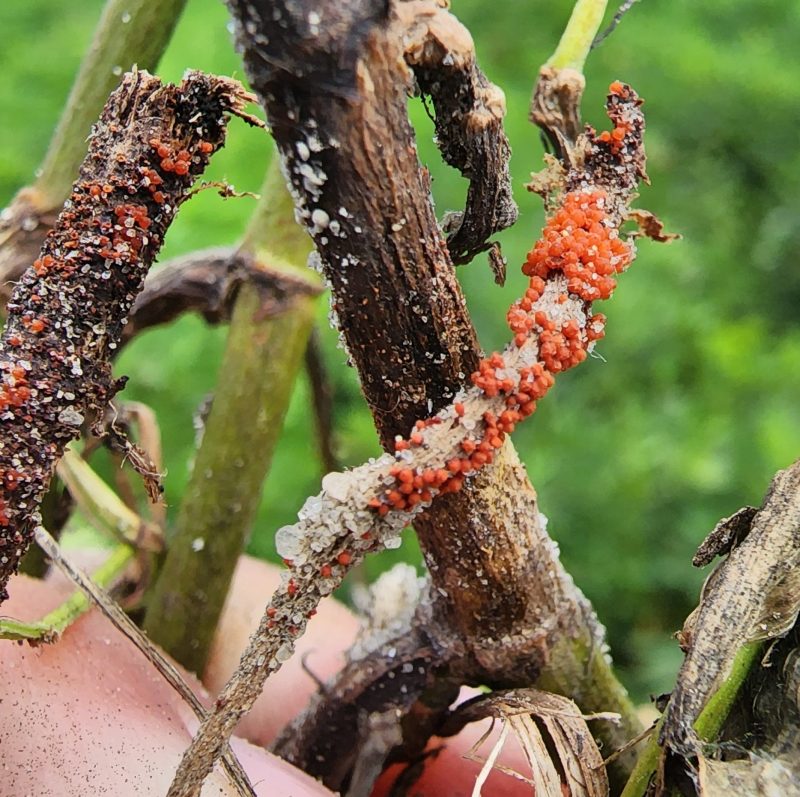As we approach the end of the 2024 peanut season, it’s time to reflect on some of the major disease challenges observed this year and how they may impact planning for 2025. Soilborne diseases like white mold (southern stem rot) and Cylindrocladium Black Rot (CBR) as well as the soilborne disorder Neocosmospora pod rot have been prevalent throughout the southeastern peanut production region. Additionally, foliar diseases such as late leaf spot and peanut rust made their presence known. Here’s a quick guide to help distinguish between these common soilborne problems and what to consider for disease management in the future.
–
Identifying White Mold, CBR, and Neocosmospora Pod Rot
When it comes to soilborne diseases in peanuts, correctly identifying the culprit is essential for developing an effective management plan for next season. Below are key signs and symptoms to help differentiate between white mold, CBR, and Neocosmospora pod rot, which were all active this season.
–

Figure 1. Signs of the white mold fungus. White, cottony growth on dead peanut leaf with tan sclerotia on the soil.
White Mold (a.k.a. Southern Stem Rot)
Pathogen: Agroathelia rolfsii, fungus
Symptoms: White mold tends to attack peanuts at the stem base, where white, cottony mycelium can be seen, often accompanied by small, round, tan to brown sclerotia (fungal structures) on the plant or in the soil (Figure 1). This fungus can also damage the pods causing a problem commonly called “underground white mold”. The disease thrives in hot, humid conditions and can cause significant yield losses if left unmanaged.
Key Features: Look for the white mycelial growth and sclerotia around the crown and lower stems, especially after rain followed by hot, dry periods. Often this disease is more common in non-irrigated peanuts, where hot and dry conditions are more prevalent. This disease can appear sporadically throughout the field but can be devastating in patches or over large areas.
Cylindrocladium Black Rot (CBR)
Pathogen: Cylindrocladium parasiticum, fungus
Symptoms: Unlike white mold, CBR is more subtle and attacks the root system and lower stems, leading to reddish discoloration on the stems and crown. In severe cases, you may notice red perithecia (spore-producing structures) on the lower stems and roots (Figure 2). CBR often shows up in fields with a history of the disease or following a warm winter.
Key Features: Red perithecia near the soil line are the hallmark of CBR. However, a laboratory diagnosis may be necessary to confirm CBR, as it is often confused with Neocosmospora pod rot and white mold.
Neocosmospora Pod and Crown Rot

Figure 3. Pinkish-red fruiting structures of Neocosmospora fungus on peanut crown. Photo Credit: Dr. Barry Tillman, UF IFAS.
Causal agent: Neocosmospora spp., fungi
Symptoms: This disorder is often diagnosed after peanuts are dug, as it typically affects peanut pods in water-soaked areas and can be mistaken for other pod rot issues. However, above ground, crown necrosis and pinkish-red fruiting structures (Figure 3) can be observed, especially in plants stressed by environmental factors or tomato spotted wilt virus (TSWV).
Key Features: Look for rotting and discolored pods with minimal or no foliar symptoms, along with pinkish-red fruiting structures on the pods or crown. Due to its similarity to CBR and pythium pod rot, this disorder often requires laboratory confirmation. Fungicides are typically not recommended for managing this disorder, as it usually appears after other stresses, such as excessive moisture or TSWV, are present.
–
Foliar Disease Update: Leaf spots and Rust
Foliar diseases, particularly leaf spots, remained a significant issue in 2024, and the problem was exacerbated by the occurrence of peanut rust, coupled with excessive rainfall and persistent cloud cover. Below is a brief update on foliar diseases in 2024. For more detailed foliar disease information, use the following link: Peanut Disease Management.
Leaf spots, particularly late leaf spot (LLS), continued to pose challenges in 2024. In many cases, disease pressure was relatively low early in the season but intensified later in production areas across the state. Effective management of these pathogens, even with resistant varieties, requires careful fungicide selection and application timing. For instance, FRAC group 11 (QoI fungicides) are ineffective against early leaf spot (ELS) (Figure 4 A) but can still be a reasonable management option for LLS (Figure 4 B). Therefore, using fungicide rotations and mixtures, especially when ELS is present, is strongly recommended.
Complicating matters in 2024, peanut rust began appearing in early August and was found in new areas around the state through September. Fortunately, despite favorable weather conditions, the disease did not spread as quickly as it did in 2023. However, in the absence of a fungicide program, the combination of leaf spot and rust led to significantly reduced yields. Many of the fungicides used for leaf spot management, including the FRAC 11 fungicides mentioned above, are also effective against peanut rust.
Managing foliar disease pathogens begins with crop rotation, whenever feasible. Additionally, the destruction or rapid decomposition of peanut debris can help delay the onset of foliar diseases and enhance the effectiveness of any fungicide program.
–
Looking Ahead to 2025
As the 2024 peanut season ends, now is the ideal time to record and evaluate your disease conditions and make notes for next year’s management plans. Soilborne diseases like white mold and CBR can be managed with early-season fungicide applications; however, these are not as effective as proper crop rotations and varietal selection. Foliar diseases will continue to pose challenges in 2025, so it’s crucial to review your fungicide programs, especially if you experienced issues with disease resistance or timing.
If you need assistance identifying the diseases in your fields or want to discuss management options for next season, don’t hesitate to reach out to your Local Extension Office or the UF/IFAS Florida Peanut Team.
Remember: Proper disease identification is key to effective management. A proactive approach, backed by research and field observations, will help keep your peanut crops healthy and productive in the coming years.
- 2025 End-of-Season Florida Peanut Disease Notes - October 24, 2025
- Southern Rust Confirmed in the Florida Panhandle – June 2025 - June 6, 2025
- Stay Ahead of Disease with the Spore Report: A New Tool to Assist with Potato and Watermelon Management - April 11, 2025



